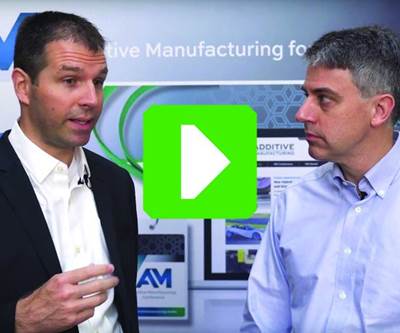Surgical Guides Illustrate Promise of Mass Customization; “Up Front is Where Most Value Created,” Says Materialise’s Vancraen
Interconnected software systems allow for production via additive manufacturing of a product tailored to individual surgeries.
Share
Read Next
Realizing the full promise of additive manufacturing (AM) will be the result of software innovation every bit as much as the further development of 3D printing hardware. This is particularly true where that promise relates to production of components that are tailored to the individual.
There is nothing new in this insight. However, it was particularly apparent to me during a recent visit to the U.S. headquarters of Materialise in Plymouth, Michigan. The site not only serves users of the Belgium-based company’s AM software products—including Magics for build preparation and Streamatics for AM process management—it also manufactures custom surgical guides within a separate business unit employing a data system developed for this specific use.
Surgical guides tailored to individual patients provide a hard template directing the surgeon precisely where to cut during a procedure such as joint replacement. The surgery can therefore proceed more quickly and accurately, with the patient open on the operating table for a shorter time.
Even though this product is individualized and unique to every person, it is mass produced, and at Materialise I got a glimpse of the interlinking software tools that make this mass customization possible.
A computed tomography (CAT) scan of the patient provides the data sent to Materialise. A proprietary system created by the company to serve this market automatically creates a guide design and surgical plan that is returned to the surgeon for approval. Then, once approved, Streamatics software tracks the part, schedules the build based on capacity and the urgency of the procedure, and maintains the data record a medical component requires. Meanwhile, Magics software ensures efficient 3D printing time by nesting parts made from the same material within a build that puzzles the parts together into the mathematically smallest volume possible. Because the process used to produce the guides is selective laser sintering (SLS), which does not generally require support structures, this nesting can be arranged in three axes. The Plymouth site has five SLS machines, which together provide for a volume of production frequently exceeding 1,000 surgical guides per month, while also making other parts for the company’s prototyping and manufacturing business unit.
“Up front, before the part begins to print, is where most of the value is created,” says Materialise founder Wilfried Vancraen, whom I had a chance to meet during my visit. He sees “verticalization” — creating value within vertical markets by building systems that allow for customization — being a continued way forward for the company. For example, the company also makes individually customized eyewear, 3D printed in a facility in Poland. In serving these verticals, nothing about the 3D printer itself changes — its capability is already sufficient — but instead the promise of the 3D printer opens up because of a system that can transform an individual’s choices or data into mass-customized production. Vancraen says his own company’s size and bandwidth are the limiting factors on serving these verticals, not the availability of potential options. He believes there is so much opportunity in serving patients or consumers with various forms of tailor-made products that “we have to be selective in what we pursue.”
Related Content
Machine Tool Drawbar Made With Additive Manufacturing Saves DMG MORI 90% Lead Time and 67% CO2 Emission
A new production process for the multimetal drawbar replaces an outsourced plating step with directed energy deposition, performing this DED along with roughing, finishing and grinding on a single machine.
Read MoreWhat Is Neighborhood 91?
With its first building completely occupied, the N91 campus is on its way to becoming an end-to-end ecosystem for production additive manufacturing. Updates from the Pittsburgh initiative.
Read MoreVideo: 5" Diameter Navy Artillery Rounds Made Through Robot Directed Energy Deposition (DED) Instead of Forging
Big Metal Additive conceives additive manufacturing production factory making hundreds of Navy projectile housings per day.
Read MoreBeehive Industries Is Going Big on Small-Scale Engines Made Through Additive Manufacturing
Backed by decades of experience in both aviation and additive, the company is now laser-focused on a single goal: developing, proving and scaling production of engines providing 5,000 lbs of thrust or less.
Read MoreRead Next
Video: Smith & Nephew on 3D Printing Patient-Specific Surgical Instruments
Using MRI and additive manufacturing to produce a cutting block customized to the patient aids the precision of the surgery.
Read MoreProfilometry-Based Indentation Plastometry (PIP) as an Alternative to Standard Tensile Testing
UK-based Plastometrex offers a benchtop testing device utilizing PIP to quickly and easily analyze the yield strength, tensile strength and uniform elongation of samples and even printed parts. The solution is particularly useful for additive manufacturing.
Read MoreAlquist 3D Looks Toward a Carbon-Sequestering Future with 3D Printed Infrastructure
The Colorado startup aims to reduce the carbon footprint of new buildings, homes and city infrastructure with robotic 3D printing and a specialized geopolymer material.
Read More





















